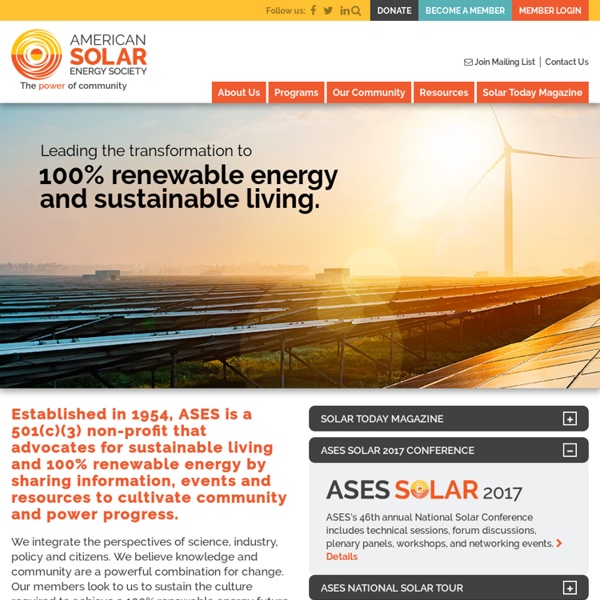



Distributed generation Distributed generation, also called on-site generation, dispersed generation, embedded generation, decentralized generation, decentralized energy, distributed energy or district energy,[1] generates electricity from many small energy sources. Most countries generate electricity in large centralized facilities, such as fossil fuel (coal, gas powered), nuclear, large solar power plants or hydropower plants. These plants have excellent economies of scale, but usually transmit electricity long distances and can negatively affect the environment. Local wind generator, Spain, 2010 Economies of scale[edit] Historically, central plants have been an integral part of the electric grid, in which large generating facilities are specifically located either close to resources or otherwise located far from populated load centers. For example, coal power plants are built away from cities to prevent their heavy air pollution from affecting the populace. Grid parity[edit] Cogeneration[edit] Microgrid[edit]
Complete Green Job Search Guide|Green Career Resources for Job S Aprovecho Research Center Renewable Energy Certificates (United States) Renewable Energy Certificates (RECs), also known as Green tags, Renewable Energy Credits, Renewable Electricity Certificates, or Tradable Renewable Certificates (TRCs), are tradable, non-tangible energy commodities in the United States that represent proof that 1 megawatt-hour (MWh) of electricity was generated from an eligible renewable energy resource (renewable electricity). Solar renewable energy certificates (SRECs) are RECs that are specifically generated by solar energy. These certificates can be sold and traded or bartered, and the owner of the REC can claim to have purchased renewable energy. According to the U.S. Department of Energy's Green Power Network,[1] RECs represent the environmental attributes of the power produced from renewable energy projects and are sold separately from commodity electricity. Once in the grid, renewable energy is impossible to separate from the conventionally generated energy.
Everblue - LEED AP Certification Exam Prep Courses, LEED Consult In 2013, 70% more homes were energy rated in the U.S. and issued a HERS Index Score. There were 218,864 ratings conducted in 2013, compared to 128,000 in 2012. RESNET Executive Director Steve Baden commented on this increase, “These numbers reflect that home energy ratings are fast becoming a mainstream in the U.S. housing market. It is also encouraging th at the average HERS Index Score was 64. Baden acknowledges that homebuilders are increasingly seeing energy efficiency as a major selling point for buying a new home. Legislation to Support Energy Auditing in 2014 Senators Jeanne Shaheen (D-NH) and Rob Portman (R-OH) announced that energy efficiency legislation will be reintroduced shortly. The legislation will include the SAVE Act. Shaheen, who has co-sponsored the legislation (S. 1392) with Portman, told the Senate Energy and Natural Resources Committee's Energy Subcommittee that the bill had a “great chance” of becoming law due to bipartisan support in both chambers. inShare5
Solar Energy, Solar Power, Solar Heating, Photovoltaics, solar e Community Associations Network Green Building Books & Resources | Yudelson Associates Jerry Yudelson has written more green building books than anyone. Each book presents case studies, anecdotes and concrete facts that offer inspiration and encouragement for any green building initiatives. Jerry’s first three books virtually invented the field of green building marketing, and the next five continue to expand the reach of the green building message. From developers and government officials to corporate decision-makers and educational leaders, each of the titles below addresses a specific needs in the green building industry. Please use the links below to learn more, and when you find the best green building book for you, click on the link to find the best place to order it. BlueTech Forum 2012 – The Water Technology Opportunity in Green Buildings, Jerry Yudelson Watch the video Our New YouTube Water Conservation Video Series: “Water Wars” Read the blog post with links to the videos Go directly to the “Water Wars” YouTube playlist Download Jerry’s chapter. back to top back to top
Mr. Sun Solar Can We Go Green? Check Your Condo Documents Before Launching Green Initiatives By Matthew Worley Article Options As gasoline prices rise with increasing summer demand, American thoughts focus sharply on the cost of energy and ways to trim fat from their overall energy budgets. Has your condo property gone green? “I think what you’re seeing is just the beginning of those types of questions arising for [condo] associations,” says Mitchell Frumkin, president of Kipcon, Inc., a New Jersey-based engineering and consulting firm that provides condo reserve and transition studies. Who Owns That Component? The problems, experts note, arise from the unique legal aspects of a condo community. “Mortgage holders have specific rights,” says New Hampshire attorney Jon Wilkinson, “and for a condominium that wants to make some fairly big changes – whether it’s changing out an HVAC system or installing new utilities that are more energy efficient – that can potentially impact mortgage holder rights.” Easy Fixes Abound